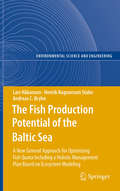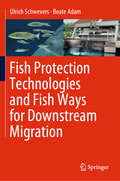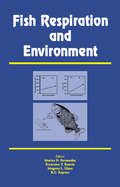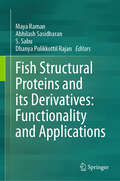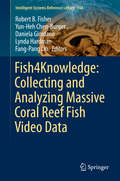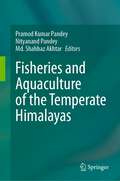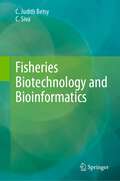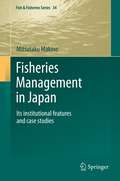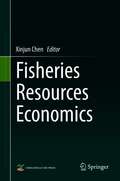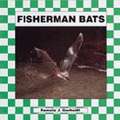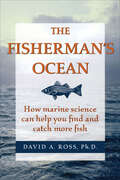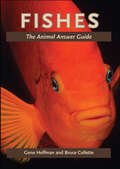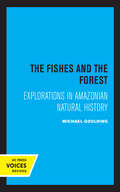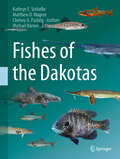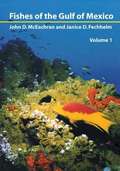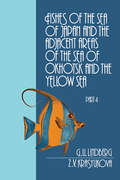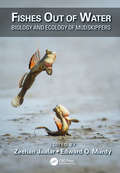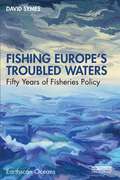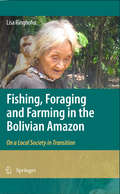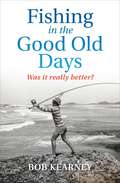- Table View
- List View
The Fish Production Potential of the Baltic Sea
by Andreas C. Bryhn Lars Håkanson Henrik Ragnarsson StaboIt presents a new approach to set fish quota based on holistic ecosystem modeling (the CoastWeb-model) and also a plan to optimize a sustainable management of the Baltic Sea including a cost-benefit analysis. This plan accounts for the production of prey and predatory fish under different environmental conditions, professional fishing, recreational fishing and fish cage farm production plus an analysis of associated economic values. Several scenarios and remedial strategies for Baltic Sea management are discussed and an "optimal" strategy motivated and presented, which challenges the HELCOM strategy that was accepted by the Baltic States in November 2007. The strategy advocated in this book would create more than 7000 new jobs, the total value of the fish production would be about 1600 million euro per year plus 1000 million euro per year related to the willingness-to-pay to combat the present conditions in the Baltic Sea. Our strategy would cost about 370 million euro whereas the HELCOM strategy would cost about 3100 million euro per year. The "optimal" strategy is based on a defined goal - that the water clarity in the Gulf of Finland should return to what it was 100 years ago.
Fish Protection Technologies and Fish Ways for Downstream Migration
by Ulrich Schwevers Beate AdamThis book offers a comprehensive review of current systems for fish protection and downstream migration. It offers the first systematic description of the currently available technologies for fish protection at hydropower intakes, including accurate and timely data collected by the authors and other researchers. It describes how to design and test them in agreement with the guidelines established from the EU Water Framework Directive. The book includes important information about fish biology, with a special focus on swimming and migration mechanisms. It offers a robust bridge between concepts in applied ecology and civil hydraulic engineering, thus providing biologists and hydraulic engineers with an authoritative reference guide to both the theory and practice of fish protection. It is also of interest for planners, public authorities as well as environmental consultants
Fish Respiration and Environment
by Marisa N. FernandesGills of healthy fishes are their lifeline to meet the challenges arising from their changing environment: oxygen gradient, alkalinity, temperature fluctuations and the added pollutants. The diverse and ever changing aquatic environment has a major impact on the organization of various organ-systems of fishes. This book contains seventeen chapters
Fish Structural Proteins and its Derivatives: Functionality and Applications
by Maya Raman Dhanya Pulikkottil Rajan Abhilash Sasidharan S. SabuThis book brings out a comprehensive collection of information on the structural proteins of fish in both marine and fresh water system. The main focus of this book is to address all relevant aspects of structural proteins of fish and its commercial significance. Fish is a rich and cheap source of protein, and the collagen and myofibrillar proteins, play a key role in food and pharmaceutical industries. Marine-based collagen due to its unique properties have fewer risks of transmitting diseases. These have low molecular weight, are biocompatible, lack religious constraints, and involves cost-effective extraction process. Therefore, it finds wide biomedical applications. The details of its extraction, isolation and characterization, supported with photographs and flow-charts are provided. This book also discusses the different peptides and derivatives of proteins that may have beneficial health significance and other commercial importance. Further, the application of bioinformatics and artificial intelligence in understanding the protein structure in-silico are also discussed in detail. This book is of interest and useful to students, academician, researchers and industrialists/ entrepreneurs, and is a valuable source of reference to the relevant researchers/ students.
Fish Waste to Valuable Products (Sustainable Materials and Technology)
by Sajid Maqsood Muhammad Nihal Naseer Soottawat Benjakul Asad A. ZaidiThis book provides a comprehensive overview of recent developments to valorize fish waste as a source of useful products. In the first few chapters, an introductory section unearths global fish waste production, its detrimental effects and its role in the circular economy. The next section of the book discusses recent applications of fish waste and by-products utilization for the production of useful products such as fertilizers, biogas, biodiesel, fish sauce, enzymes and many more. This book will serve as an important source of recent research developments and applications of fish waste generated at different stages of fish processing. This book will also act as an important reference to the research group conducting research on fish and fish by-product utilization and valorization.
Fish4Knowledge: Collecting and Analyzing Massive Coral Reef Fish Video Data
by Robert B. Fisher Yun-Heh Chen-Burger Daniela Giordano Lynda Hardman Fang-Pang LinThis bookgives a start-to-finish overview of the whole Fish4Knowledge project, in 18short chapters, each describing one aspect of the project. The Fish4Knowledgeproject explored the possibilities of big video data, in this case fromundersea video. Recording and analyzing 90 thousand hours of video from tencamera locations, the project gives a 3 year view of fish abundance in severaltropical coral reefs off the coast of Taiwan. The research system built aremote recording network, over 100 Tb of storage, supercomputer processing,video target detection and tracking, fish species recognition and analysis, alarge SQL database to record the results and an efficient retrieval mechanism. Novel user interface mechanisms were developed to provide easy access formarine ecologists, who wanted to explore the dataset. The book is a usefulresource for system builders, as it gives an overview of the many new methodsthat were created to build the Fish4Knowledge system in a manner that alsoallows readers to see how all the components fit together.
Fisheries and Aquaculture of the Temperate Himalayas
by Pramod Kumar Pandey Nityanand Pandey Md. Shahbaz AkhtarThis book covers all aspects of fisheries and aquaculture of the temperate Himalayas, including fisheries resources, fish biodiversity, aquaculture status, prospects, and potential. It also includes mapping of resources, health and disease management of cultured species, feed and nutritional aspects of the cultured fish species, ornamental fisheries aspects, etc. In addition, it elucidates the recent advances in biotechnological interventions for enhancing fisheries and aquaculture productivity in the region. Essential information on the application of Geo Information System (GIS) for resource mapping, the scope of adopting re-circulatory aquaculture system for productivity enhancement, and trout culture in the Himalayan waters are provided in the book. A detailed account of recreational fisheries and fish-based ecotourism in the temperate Himalayas for generating livelihood has been provided. The impact of climate change on the fisheries of the Himalayas has been dealt with separately. The book also covers the conservation and rehabilitation aspects of endangered species of the region. This book will become a ready reference for the scientists, teachers, researchers, students, policymakers, and other stakeholders for managing fishery resources in the temperate Himalayas.
Fisheries Biotechnology and Bioinformatics
by C. Judith Betsy C. SivaThis authored book is focused on SDG 14: Life below water, comprehensively addressing all facets of biotechnology and bioinformatics related to fisheries. It offers an extensive exploration of the detail on structure, function and types of nucleic acids, concepts of gene and genetic code, mutations, and their implications. The book provides essential information on gene regulation and expression in prokaryotes and eukaryotes. Step-by-step descriptions are provided for technologies such as gene transfer, rDNA, transgenic fish production, animal cell culture, hybridoma technology and cryopreservation technology in fishes. Special emphasis has been given to topics like RNA in gene regulation, epigenetics, and DNA and protein sequencing. Various molecular techniques and markers have been discussed in detail. Further, various topics on bioinformatics including different databases, formats, sequence retrieval, manipulation, analysis, primer design, molecular visualization, genomics, and proteomics are also covered. This volume will prove invaluable to aquaculturists, equipping them with essential techniques and protocols. It constitutes essential reading for students enrolled in aquaculture or fisheries courses within tropical and sub-tropical regions.
Fisheries Management in Japan
by Mitsutaku MakinoJapan is one of the world's largest fish-eating countries with a long history, and has developed its own customs and values in terms of managing fisheries resources. The first half of this book introduces the history and institutional features of capture fisheries management in Japan, with 9 case studies from sub-arctic to tropical ecosystems, from sedentary to migratory species, and from small-scale coastal to offshore industrial fisheries. For example, coastal fisheries management is more community-based, and local people have the authority and take priority in the decision-making process. In contrast, offshore fisheries are more industrialized and commercially oriented, and the national government plays a major role in their management. One of the main challenges in world fisheries is to implement the ecosystem approach, but there is no one-size-fits-all solution for its implementation. The second half of this book considers the advantages and limitations of the Japanese fisheries management regime and discusses the necessary environmental policy measures to bridge the gaps between fisheries management and ecosystem-based management. As a case study, management measures in the Shiretoko World Natural Heritage area are analyzed. In closing, the Grand Plan of Japanese fisheries policy for the next 20 years and three future scenarios are presented.
Fisheries Resources Economics
by Xinjun ChenFisheries resources are an important component of natural resources. It is an important source of high-quality animal protein and food for humans, which provides employment, economic benefits and social welfare for people engaged in fishing activities. It also has played an important role in food safety, economic development, and foreign trade. Fisheries resources economics is an important branch of both applied economics and resource economics. Its research object is fishery resources and its economic problems. The economics of fishery resources is to focus on the relationship between the demand for human economic activities and the supply of fishery resources, as well as between fishery resources and its development. This book expounds the reasons for the economic problems of fishery resources and the theoretical principles for solving them, so as to reveal the objective rules of the allocation of fishery resources in different regions and at different times, to coordinate the relationship between the utilization of fishery resources and economic development, and to realize the sustainable development of fishery economy. This book will also provide learning materials for undergraduates, graduate students and practitioners engaged in fishery resources development and scientific management.
Fisherman Bats (Bats)
by Pamela J. GerholdtWhat are fisherman bats? Where do they live? How big are they? Find out all about the characteristics, habitat, and behaviors of the Fisherman bat.
The Fisherman's Ocean: How Marine Science Can Help You Find and Catch More Fish
by David A Ross PhDThis volume &“clearly explains how marine science can help saltwater anglers catch more and bigger fish . . . comprehensive yet accessible&” (Booklist). Here at last, in layman&’s terms, is a fisherman's guide to the habitat and behavior of saltwater fish. The author, an oceanographer and avid fly fisherman, explains the marine environment and the factors that affect where game fish congregate—everything from how they move with tides and currents to what they see, smell, taste, and hear. The copiously illustrated text covers inshore and offshore habitat and will prove invaluable to anyone who fishes in saltwater, whether in the surf, on the flats, or out at sea. The ocean is vast. It pays to be educated.
Fisher�s Techniques of Crime Scene Investigation First International Edition
by William J. Tilstone Michael L. Hastrup Camilla HaldBarry Fisher‘s Techniques of Crime Scene Investigation has long been considered the "bible" of the crime-solving profession, drawing from the author‘s 40-year career in forensic science, including his time spent as the crime laboratory director for the Los Angeles County Sheriff‘s Department. Now for the first time, com
Fishes: A Field and Laboratory Manual on Their Structure, Identification and Natural History
by Gregor Cailliet Milton Love Alfred EbelingNow available from Waveland Press, this comprehensive, geographically balanced manual offers readers complete hands-on coverage of morphology, identification, and classification, physiological adaptations, and natural history. The book's taxonomic and geographic coverage is impressively broad as well, applying to a variety of fishes and areas: jawless, cartilaginous, and bony, fresh- and saltwater, temperate and tropical, and inshore and offshore. Helpful discussions and explanations introduce the guidebook's collection of well-designed exercises, making the connections between principles and specific inquiries easier to formulate. This approach works to help readers transform memorized facts into concepts that stimulate further explorations.
Fishes: A Guide to Their Diversity
by Philip A. HastingsThere are more than 33,000 species of living fishes, accounting for more than half of the extant vertebrate diversity on Earth. This unique and comprehensive reference showcases the basic anatomy and diversity of all 82 orders of fishes and more than 150 of the most commonly encountered families, focusing on their distinctive features. Accurate identification of each group, including its distinguishing characteristics, is supported with clear photographs of preserved specimens, primarily from the archives of the Marine Vertebrate Collection at Scripps Institution of Oceanography. This diagnostic information is supplemented by radiographs, additional illustrations of particularly diverse lineages, and key references and ecological information for each group. An ideal companion to primary ichthyology texts, Fishes: A Guide to Their Diversity gives a broad overview of fish morphology arranged in a modern classification system for students, fisheries scientists, marine biologists, vertebrate zoologists, and everyday naturalists. This survey of the most speciose group of vertebrates on Earth will expand the appreciation of and interest in the amazing diversity of fishes.
Fishes: The Animal Answer Guide (The Animal Answer Guides: Q&A for the Curious Naturalist)
by Gene Helfman Bruce ColletteOne fish, two fish, red fish, nearly thirty thousand species of fish—or fishes, as they are properly called when speaking of multiple species. This is but one of many things the authors of this fascinatingly informative book reveal in answering common and not-so-common questions about this ubiquitous group of animals.Fishes range in size from tiny gobies to the massive Ocean Sunfish, which weighs thousands of pounds. They live in just about every body of water on the planet. Ichthyologists Gene Helfman and Bruce Collette provide accurate, entertaining, and sometimes surprising answers to over 100 questions about these water dwellers, such as "How many kinds of fishes are there?" "Can fishes breathe air?" "How smart are fishes?" and "Do fishes feel pain?" They explain how bony fishes evolved, the relationship between them and sharks, and why there is so much color variation among species. Along the way we also learn about the Devils Hole Pupfish, which has the smallest range of any vertebrate in the world; Lota lota, the only freshwater fish to spawn under ice; the Candiru, a pencil-thin Amazonian catfish that lodges itself in a very personal place on male bathers and must be removed surgically; and many other curiosities.With more than 100 photographs—including two full-color photo galleries—and the most up-to-date facts on the world's fishes from two premier experts, this fun book is the perfect bait for any curious naturalist, angler, or aquarist.
Fishes: An Introduction to Ichthyology
by Peter B. Moyle Joseph J. CechThis book provides a comprehensive and current source of information on fishes--including systematics, zoogeography, behavior, and conservation of fishes--that is often needed by professionals as background for writing accurate reports. This book covers the structure and physiology, evolution and taxonomy, zoogeography, and ecology and conservation of fishes. For fisheries biologists, conservation biologists, and aquatic ecologists that need an up-to-date reference on Ichthyology.
The Fishes and the Forest: Explorations in Amazonian Natural History
by Michael GouldingThis title is part of UC Press's Voices Revived program, which commemorates University of California Press’s mission to seek out and cultivate the brightest minds and give them voice, reach, and impact. Drawing on a backlist dating to 1893, Voices Revived makes high-quality, peer-reviewed scholarship accessible once again using print-on-demand technology. This title was originally published in 1980.
Fishes of the Dakotas
by Kathryn E. Schlafke Matthew D. Wagner Chelsey A. PasbrigThis book describes all of the fishes found in North and South Dakota, USA. It contains a description of the waters and geology of the two states, information on the major rivers and water basins, detailed distribution tables, and a dichotomous key (already tested and in university use). A brief description of each fish family is included, and for each individual fish species found in North and South Dakota, high resolution color images, range maps, descriptions, and life histories are included. All of the information is referenced. The book also shows all of the fish sampling sites, briefly describes the history of fish sampling and identification in the Dakotas, and mentions the prominent individuals. This is the first book of its kind - the first comprehensive compilation describing every fish found in the Dakotas with all of the supplemental information.
Fishes of the Gulf of Mexico: Myxiniformes to Gasterosteiformes
by John D. Mceachran Janice D. FechhelmThe Gulf of Mexico is the ninth largest body of water in the world and contains over 15 percent of all known species of marine fishes. This diverse fish fauna has been the subject of many publications, but, until now, no work has ever surveyed all known species, including the deep sea fishes and those of the southern Gulf.<P><P>This book is the first of two volumes that will cover the entire fish fauna of the Gulf of Mexico. An introductory section that outlines the Gulf's geographical setting, geological origin, current patterns, tides, sediments, meteorology, ecology, and biological exploration is followed by a key for the forty-four orders of fishes known from the Gulf. Keys and descriptions are provided for families, which are arranged phylogenetically, and for the species, which are arranged alphabetically, described, and distinguished from similar species. All but a few species are illustrated.
Fishes of the Sea of Japan and the Adjacent Areas of the Sea of Okhotsk and the Yellow Sea
by G.U. LindbergThis part completes the review of the largest and economically richest order of fishes, Perciformes, begun in Part 3. It includes 12 suborders with keys and brief descriptions to 230 species, and information on their ecology and distribution.
Fishes Out of Water: Biology and Ecology of Mudskippers (CRC Marine Science)
by Zeehan Jaafar Edward O. MurdyMudskippers are amphibious fishes native to the Indo-West Pacific and tropical western Africa. Unlike most fishes, mudskippers emerse to forage, find mates, and defend territories. Adaptations to their morphology, physiology and behavior enable mudskippers to accommodate both aquatic and terrestrial habitats. For these traits, mudskippers have long captured the fascination of scientists, naturalists, and fish hobbyists. Some mudskipper taxa (e.g. Periophthalmodon spp., Periophthalmus spp., Boleophthalmus spp.) are readily observed on mudflats and mangrove forests during the ebb tide. Correspondingly, these conspicuous and widespread taxa are relatively well-studied. The autecology and basic biology for the remaing taxa (e.g. Apocryptodon spp. and Oxuderces spp.) are still poorly understood. Fishes Out of Water: Biology and Ecology of Mudskippers is the first comprehensive book to synthesize published scientific information and observation on these fishes. Two dozen subject experts present thorough overviews in fifteen distinct chapters. Contents span mudskipper anatomy, distribution, systematics, physiology, ecology, and conservation. Unique adaptations to terrestriality are discussed within the context of each chapter foci. This authoritative reference equips the reader with the basic foundation to understand mudskipper biology and ecology, while providing a framework in which emerging data are discussed. The book will be of interest to a broad range of students, researchers, and professionals in ichthyology, evolution, ecology, animal behavior, and comparative physiology.
Fishing Europe's Troubled Waters: Fifty Years of Fisheries Policy (Earthscan Oceans)
by David SymesSpanning the last 50 years of fisheries policy in Europe, this book is the parting contribution and career-spanning reflection from one of Europe’s most renowned social scientists working in the field of fisheries management and policy. The last 50 years have without doubt been the most turbulent years in the history of North Atlantic fisheries – a turbulence brought about by the actions of fishers, scientists and above all politicians. It is a period of change that sees a radical redrawing of the political geography of fisheries, globalisation of trade, the development of fisheries management towards increasingly restrictive regulation, and declining fish stocks. The book explains why the bold but deeply flawed Common Fisheries Policy persistently failed to deliver its basic goal of sustainable fisheries. The spotlight falls on the monolithic, highly centralised, command and control nature of the Policy that strives to apply a universal ‘one size fits all’ approach, thus creating a governing system wholly unsuited to the system to be governed, out of kilter with preferred models of governance, and disconnected from the practical realities of fishing as a livelihood in a challenging environment. A final section on Brexit focuses on its halting progress from concept to reality, the implications for the fisheries sector and the fateful final negotiations with the EU over the fisheries question. Seeking to explain why the anticipated benefits for the UK industry failed to materialise, attention is drawn to the misplaced political hubris over regaining ‘sovereignty’ in areas like the North Sea. This book will be essential reading for students, scholars, professionals and policymakers working on fisheries, marine governance, natural resource management, environmental policy and the European Project.
Fishing, Foraging and Farming in the Bolivian Amazon
by Lisa RinghoferEmpirical in character, this book analyses the society-nature interaction of the Tsimane', a rural indigenous community in the Bolivian Amazon. Following a common methodological framework, the material and energy flow (MEFA) approach, it gives a detailed account of the biophysical exchange relations the community entertains with its natural environment: the socio-economic use of energy, materials, land and time. Equally so, the book provides a deeper insight into the local base of sociometabolic transition processes and their inherent dynamics of change. The local community described in this publication stands for the many thousands of rural systems in developing countries that, in light of an ever more globalising world, are currently steering a similar - but maybe differently-paced - development course. This book presents insightful methodological and conceptual advances in the field of sustainability science and provides a vital reader for students and researchers of human ecology, ecological anthropology, and environmental sociology. It equally contributes to improving professional development work methods.
Fishing in the Good Old Days: Was it really better?
by Bob KearneyBob Kearney has been addicted to recreational fishing and is a devout keeper of the legends and lore of the Australian angler. He is also a world authority on fisheries and marine ecosystem management. In Fishing in the Good Old Days, Kearney looks back on his six decades of experience as a fisherman in earnest pursuit of the iconic jewfish off the rocks and beaches of northern New South Wales. He recalls unforgettable adventures, colourful personalities, the thrill of the chase and, yes, the ones that got away. Along the way, he exposes the environmental consequences of poorly planned coastal activities. Kearney also addresses a serious question: Is the holistic experience of fishing for fun, now, truly not as good as it was in the 1960s? Of course, this question rests on many others about recreational and commercial fishing practice, fisheries management, coastal and marine conservation, and the impact of the terrestrial world, including through human population growth and climate change. With a grasp of the scientific research as acute as his ear for the anglers' voices of his youth, Kearney demonstrates that the answer to his question is far from straightforward.
